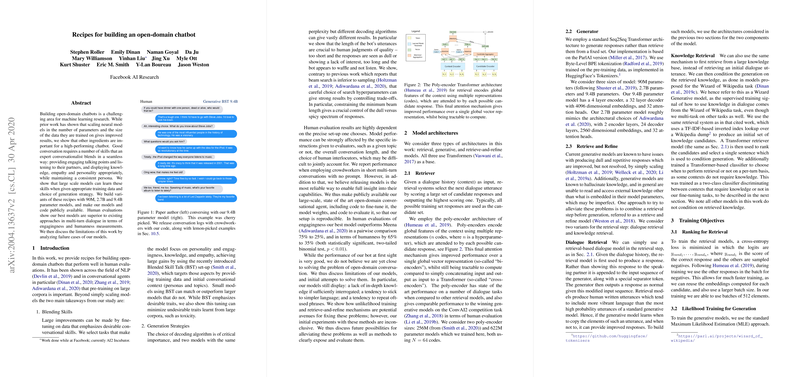An Overview of "Recipes for Building an Open-Domain Chatbot"
The paper "Recipes for Building an Open-Domain Chatbot" by Stephen Roller et al., from Facebook AI Research, investigates the underlying principles and methodologies essential for constructing high-performance open-domain conversational agents. This paper acknowledges that while the scaling of neural models has yielded notable improvements in chatbot design, a multitude of nuanced elements are crucial in achieving human-like dialogue capabilities. This essay encompasses a detailed examination of the models, strategies, and results delineated in the research.
Key Findings
Blending Skills
A major conclusion of the paper is that emphasizing specific conversational skills during fine-tuning delivers significant enhancements in chatbot performance. The authors employ the Blended Skill Talk (BST) dataset to target personality, engagement, knowledge, and empathy. They demonstrate that even smaller models fine-tuned on BST can outperform larger models without such fine-tuning.
Generation Strategies
The choice of decoding strategy is paramount. The paper emphasizes that model performance varies dramatically with different decoding algorithms, even when models share the same perplexity. Specifically, the authors found that controlling the length of bot responses greatly impacts human judgment of quality. They propose and validate the effectiveness of using minimum length constraints and predictive length algorithms in beam search decoding.
Model Architecture
The paper explores three architecture variants: retrieval, generative, and retrieve-and-refine (RetNRef). All architectures utilize Transformers.
- Retrieval Models: These involve scoring a set of candidate responses using poly-encoder architecture.
- Generative Models: These employ a Sequence-to-Sequence (Seq2Seq) Transformer structure.
- Retrieve-and-Refine Models: These hybrid models use an initial retrieval step followed by generative response refinement.
Numerical Results
The paper provides substantial numerical evaluation in terms of perplexity and hits@1/K metrics, with substantial improvements shown through fine-tuning. For instance, the fine-tuned 2.7B parameter model achieves a perplexity of 8.98 on BST tasks versus 13.71 before fine-tuning. Additionally, human evaluations demonstrate the superiority of these models over existing chatbots, including Google's Meena, in both engagingness and humanness measurements.
Implications and Future Directions
Practical Implications:
- Human Evaluations: The comprehensive use of ACUTE-Eval for pairwise human evaluations provides a robust mechanism to compare chatbot performance, ensuring subjective human preferences are quantitively captured.
- Reproducibility: The release of model code and weights promotes transparency and reproducibility in the research community, which is crucial for advancing the field collectively.
Theoretical Implications:
- Decoding Techniques: The findings stress the importance of advanced decoding strategies that extend beyond traditional beam search to include length constraints and variety-inducing methods such as unlikelihood training.
- Skill Blending: Integrating multiple conversational skills into training datasets clearly results in more human-like, engaging dialogues, substantiating a multi-faceted training approach.
Future Directions:
- Extended Memory Architectures: Future systems could incorporate architectures capable of remembering long-term user interactions or maintaining coherent personas over extended conversations.
- Knowledge Integration: While current knowledge-augmented models (Wiz Generative models) present potential, further refinement is needed to seamlessly integrate retrieved knowledge without introducing errors.
- Address Repetition and Contradiction: Addressing nontrivial repetition and contradictions through advanced training regimes or novel modeling approaches remains a pivotal challenge.
Conclusion
The research presented in "Recipes for Building an Open-Domain Chatbot" elucidates critical strategies for developing sophisticated chatbots that can engage users more naturally and effectively. By combining skill-focused fine-tuning with innovative generation strategies and robust evaluation methods, this paper lays a foundational framework for future advancements in conversational AI. As research continues in this dynamic field, implementing these 'recipes' will likely yield even more intelligent and human-like dialogue systems.
